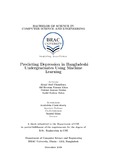| dc.contributor.advisor | Chakrabarty, Amitabha | |
| dc.contributor.author | Choudhury, Ahnaf Atef | |
| dc.contributor.author | Khan, Md Rezwan Hassan | |
| dc.contributor.author | Nahim, Nabuat Zaman | |
| dc.contributor.author | Tulon, Sadid Rafsun | |
| dc.date.accessioned | 2019-02-17T09:28:36Z | |
| dc.date.available | 2019-02-17T09:28:36Z | |
| dc.date.copyright | 2018 | |
| dc.date.issued | 2018-12 | |
| dc.identifier.other | ID 15101022 | |
| dc.identifier.other | ID 15101078 | |
| dc.identifier.other | ID 15301084 | |
| dc.identifier.other | ID 15101005 | |
| dc.identifier.uri | http://hdl.handle.net/10361/11424 | |
| dc.description | This thesis is submitted in partial fulfilment of the requirements for the degree of Bachelor of Science in Computer Science and Engineering, 2018. | en_US |
| dc.description | Includes bibliographical references (pages 75-80). | |
| dc.description | Cataloged from PDF version of thesis. | |
| dc.description.abstract | Depression is a major disorder and a growing problem that impacts a person’s way of living,
disrupting natural functioning and impeding thought processes while they might remain
oblivious to the fact that they are suffering from such a disease. Depression is especially
prevalent in the younger population of underdeveloped and developing countries. Youth in
countries such as Bangladesh face difficulties with studies, jobs, relationships, drugs, family
problems which are all major or minor contributors in a pathway to depression. Furthermore,
people in Bangladesh are not comfortable in speaking about this illness and often misinterpret
this disorder as madness. This research besides predicting depression in university undergraduates
for the purpose of recommendation to a psychiatric, focuses on gaining valuable
insights as to why university students of Bangladesh, undergraduates in particular suffer from
depression. The data for this research was collected by a survey designed after consultation
with psychologists, counsellors and professors. The survey was carried out through paper and
Google survey form. The data was analyzed to find out relevant features related to depression
using Random Forest Algorithm and then predict depression based on those features. A best
method for predicting depression among Bangladesh undergraduates was found out after
using six algorithms to train and test the dataset. Deep Learning was found to be the best
algorithm with the lowest number of false negatives, closely followed by Gradient Boost
Algorithm both with an F-Measure of 63%. Generalized Linear Model, Random Forest,
K-Nearest Neighbor and Support Vector Machine were the other four algorithms used for
comparison. The objective of this research is to determine reasons for depression and to
check whether depression can be successfully predicted with the help of related features.
Depression is an illness that people in Bangladesh tend to ignore and hence it builds up and
worsens with time. This research aims to identify depression in its early stages and ensure a
fast recovery for victims so that heartbreaking incidents like suicide can be avoided. | en_US |
| dc.description.statementofresponsibility | Ahnaf Atef Choudhury | |
| dc.description.statementofresponsibility | Md Rezwan Hassan Khan | |
| dc.description.statementofresponsibility | Nabuat Zaman Nahim | |
| dc.description.statementofresponsibility | Sadid Rafsun Tulon | |
| dc.format.extent | 80 pages | |
| dc.language.iso | en | en_US |
| dc.publisher | BRAC University | en_US |
| dc.rights | BRAC University theses are protected by copyright. They may be viewed from this source for any purpose, but reproduction or distribution in any format is prohibited without written permission. | |
| dc.subject | Depression | en_US |
| dc.subject | Machine learning | en_US |
| dc.subject | Undergraduates | en_US |
| dc.subject | Bangladeshi | en_US |
| dc.subject.lcsh | Machine learning | |
| dc.title | Predicting depression in Bangladeshi undergraduates using machine learning | en_US |
| dc.type | Thesis | en_US |
| dc.contributor.department | Department of Computer Science and Engineering, BRAC University | |
| dc.description.degree | B. Computer Science and Engineering | |

